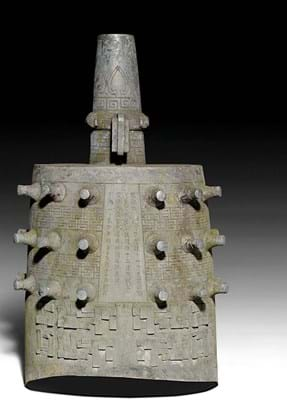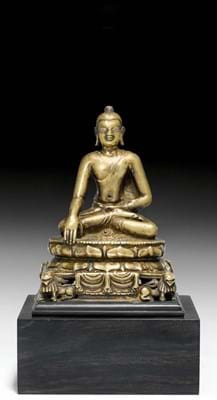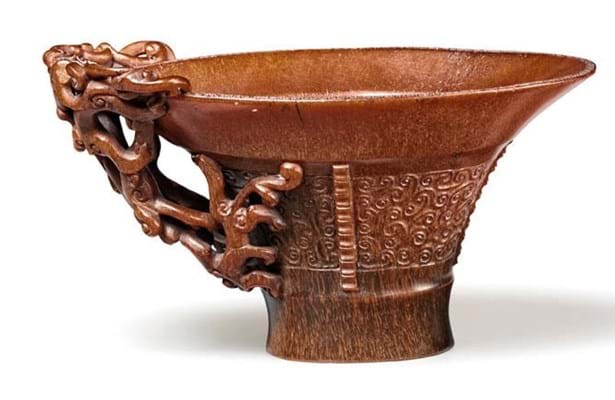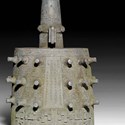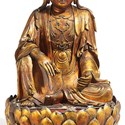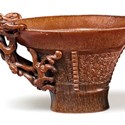Two major German auctioneers, Lempertz and Nagel, held their first sales of this type outside Germany.
As previously reported, their decision to transfer part of their sales to Brussels and Salzburg was motivated by Germany’s Kulturschutzgesetz.
This new legislation was intended to protect the status of nationally important artworks and to stem the sale of looted and otherwise illegally acquired artefacts from war-torn countries. However, at the same time it places the burden of proof on auctioneers and consignors to provide evidence of legal ownership.
On a more positive side for auctioneers, Chinese bidders were warmly welcomed at all sales and lived up to their reputation as big spenders.
Swiss on a roll
Koller (25/20/15% buyer’s premium) had good cause to celebrate after its June 13-14 sale of Asian art in Zurich.
Before the sale Koller had put a lot of effort into marketing in China and Hong Kong, which paid dividends.
Two lots went over SFr£1m, a major contribution to the final premium-inclusive total of SFr8.4m (£6.74m) that was way above the pre-sale estimate of SFr2.9m.
Soon after the sale began, a 6½in (17cm) bronze figure of Buddha Shakyamuni on a lion throne came up for sale.
The 8th or 9th century figure originated from north-eastern India and possibly came from the Nalanda Monastery in Bihar, a famous centre of Buddhist teachings up to the 12th century.
It is thought, however, to have been in Tibet for up to 1000 years and in more recent times it has been in a private collection for several generations. Offered with an unpublished ‘estimate on request’, it ended up selling for a hammer price of SFr1m (£802,675).
“Before the sale Koller had put in a lot of effort into marketing in China and Hong Kong, which paid dividends
As was to be expected, there was intense bidding for the imperial works of art which had been in a German collection for over a century (previewed in ATG No 2296, page 48).
Things got off to a flying start when the pair of 17in (42cm) long, 18th-19th century bronze censers in the shape of dragon-turtles (bixi) were taken from the guide of SFr60,000-80,000 to an impressive SFr405,000 (£361,180).
The 19th century hardwood screen illustrated in ATG No 2296, which was possibly made for the Empress Dowager Chi, changed hands for a low-estimate SFr800,000 (£642,100).
The equally rare, 2ft 9in (85cm) high bronze bell or bozhong, dated 1761 and with an inscription by Emperor Qianlong, soared from the catalogue guide of SFr200,000-300,000 to SFr1.035m (£830,405), taking the top price of the sale and, like almost all of the other high-flyers, heading back to China.
Censer stars in Cologne
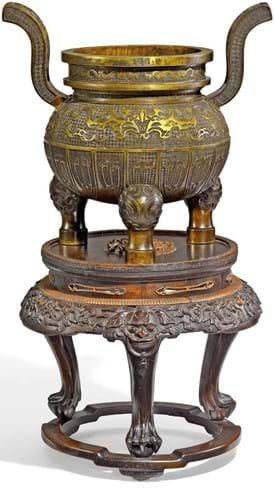
Bronze censer from the Yongzheng period of the Qing Dynasty which realised €350,000 (£304,350) at Van Ham in Cologne on June 14.
Star of the show at Van Ham (28/25% buyer’s premium) in Cologne on June 14 was a large bronze Chinese censer from the 18th century. It was cast in the Yongzheng (1722-35) period and finely decorated with numerous auspicious motifs from Chinese mythology, including bats, birds, dragons and lions.
The censer was 18in (46cm) high and 17in (42cm) in diameter. On account of its large dimensions, it was clear that it was made for a family temple or palace and the inscription jing zhi (respectfully made) would seem to confirm this.
In the 19th century a carved wooden pedestal, decorated with dragons and lions, was made to complete the ensemble.
The provenance was an extra attraction: it had been acquired in China in the late 19th century by a descendant of the consignor and had remained in the family collection since then. A photograph from about 1900 showed the censer in situ in the family home.
Nevertheless, Van Ham had put a very conservative estimate of €7000-12,000 in the catalogue. In the days before the sale, there was considerable international interest and ultimately 15 phone bidders joined in the fray.
The contest lasted almost 10 minutes and was brought to a close when one of several Chinese bidders placed the winning bid of €350,000 (£304,350).
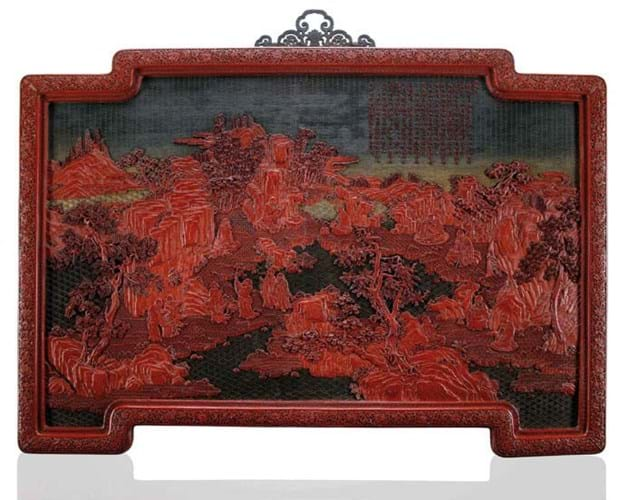
Three-colour lacquer panel which realised €450,000 (£391,305) at Nagel’s sale in Salzburg on June 16-17.
There was no shortage of noteworthy results at Nagel’s (33% buyer’s premium) first sale of Asian art in Salzburg on June 16-17, with Chinese bidders investing the most.
Among the highlights was Qi Baishi’s (1864-1957) 3ft 5in x 13in (1.04mx 34cm) ink and watercolour depiction of Buddha’s Hands Citrons and Peaches, dated 1947.
It was inscribed Great Luck and Long Life. The Old Man of the Borrowed Mountain, Baishi, in his eighty seventh year and in his thirty sixth year in the capital. The hammer price of €300,000 (£260,870) was six times the lower estimate.
In the current market situation, an imperial connection is an almost irresistible attraction for Chinese buyers. This was certainly the case with a three-colour cinnabar lacquer panel from the Qianlong (1711-99) period.
The intricately carved decoration portrayed a landscape with eight of the 16 Luohan, disciples of Buddha, who had attained sainthood through study and good deeds.
The appearance of this panel, which came from an old Austrian collection, was particularly exciting, as its counterpart with the other eight Luohan had been sold at Sotheby’s in London in November 2009 for £313,250 (inc premium).
The panel in Salzburg was in the catalogue at €80,000-120,000, but went on to sell for €450,000 (£391,305).
Two closely related 18th century porcelain vases were the subject of prolonged bidding.
The 16in (40cm) high vases were both decorated with a crane and calligraphic inscriptions in underglaze blue and copper red and bore the painted mark Taocheng tang, which is often found on imperial pieces from the Qianlong period. It is possibly the mark of Tang Ying (ca 1682-1756), who was appointed resident supervisor of the imperial kilns at Jingdezhen in 1728 and published a report, Records of Ceramic Production, around this time.
Each vase was guided at €9000- 12,000 and after vigorous efforts by numerous bidders, they each sold for €165,000 (£143,480).
Surprisingly, there were no takers for the 12th-13th century thangka depicting Lochen Rinchen Zangpo (previewed in ATG No 2296).
Asian art Brussels debut
On June 18 Cologne auction house Lempertz (24/22% buyer’s premium) held its first sale of Asian art in Brussels (Indian and Japanese works of art were sold in the first half of the auction, held on June 9 in Cologne).
The date chosen for the sale aimed to attract Chinese bidders who were in Europe for the major sales in Paris and the Brussels Cultures fair.
The timing paid off, as 90% of Chinese art went to Chinese buyers.
First up was a 4ft 4in (1.31m) high wooden sculpture of the goddess Guanyin from the 17th or 18th century. The gilded and lacquered figure was seated on a separate lotus blossom base. After a short tussle it was knocked down for a low-estimate €80,000 (£69,570).
The same price was achieved for the large Kangxi (1662-1722) famille verte vase (previewed in ATG No 2296), which had belonged to the renowned collector Henry M Knight and is now returning to China.
A Qing rhinoceros horn libation cup generated plenty of interest.
The vessel, which was just over 3in (8cm) high, was carved with C-scrolls and qi dragons and bore the mark of Hu Xingyue. Virtually nothing is known about the carver, other than that he is mentioned in the imperial archives; in all, 13 of his works have been documented.
Most of these are in museums throughout the world, a fact not lost on the bidders in Brussels who pushed the price from the lower estimate of €30,000 to a hammer price of €75,000 (£65,220).
£1 = €1.15


